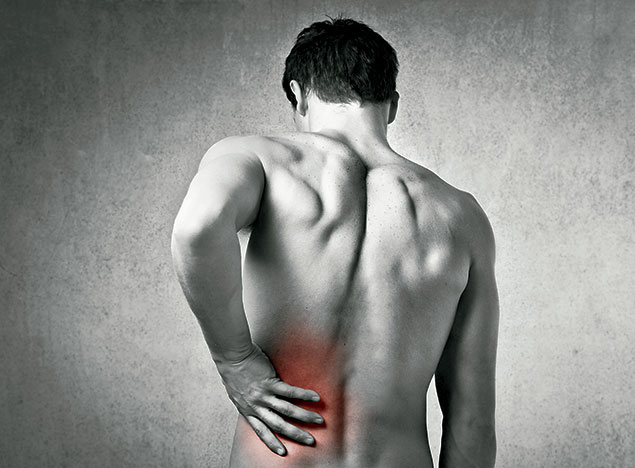Robert Moore was in bad shape. An executive for a
financial-services company, he spent long hours sitting, either at his
desk or traveling from Washington to New York. He seldom exercised—he was
in his fifties and 10 to 15 pounds overweight. Like many Washingtonians,
he was too busy to address the nagging pain in his back.
“It got to the point where I was lying on the floor of my house
unable to move because I had a sudden episode,” Moore recalls. His back
had given out in the worst way: A disk had exploded near the end of his
spinal cord, temporarily paralyzing him from the waist down. All this
time, he had been ignoring a herniated disk.
It took a seven-hour surgery at George Washington University
Hospital and more than two months of rehabilitation for Moore to learn to
sit up and walk again. While he has since made significant changes to his
life, he still suffers the occasional flare-up. “Once you have an injury
that catastrophic, you tend to always have back-pain issues,” he
says.
Although Moore’s nerve-damaging injury is rare, back pain is
not. About 80 percent of Americans suffer from acute or chronic back pain,
according to the National Institutes of Health. It’s the second-most
common reason for lost work time after the common cold.
Pain specialist Dr. Mehul J. Desai says that in the Washington
area two types of people are most likely to have back problems: workers
who sit at a desk all day and “weekend warriors” who don’t exercise
regularly but play hard on weekends. More often than not, his patients
fall into both categories.
“We have people who are hyper-scheduled at work and the gym to
the nth degree,” says Desai, director of pain medicine and nonoperative
spine services at the GW Pain Center. “Whether they’re working or playing,
it’s hard.”
Back pain often is treated improperly or, worse, goes
untreated. Fortunately, traditional back surgery isn’t the only option. A
healthy back is possible with both medical and holistic therapies—plus
making changes to your daily habits.
Exercise and Stretching
Contrary to popular belief, inactivity after a back injury does
a patient no favors, says Dr. John Dombrowski of Washington Pain Center:
“Years ago when someone had a back injury, he was told to rest. We’re
finding out that it’s the worst thing to do.”
Rest is important initially, but entering a physical-therapy
program soon after an injury is vital to recovery. Without PT, Dombrowski
says, you’re likely to experience “a longer climb back to where your body
was normally.” A physical therapist can design a safe
stretching-and-exercise regimen catered toward each patient’s fitness
level and injury.
Moore, now in his seventies, attends physical therapy twice a
month in McLean. He says he’s “religious” about walking 30 to 45 minutes
every day and wears a pedometer to make sure he gets in 10,000 steps
daily: “Now if I don’t walk every day, I am miserable and my back acts up.
There are few things that are as bad for backs as being
sedentary.”
While exercise is key to a healthy back, too much vigorous
activity can also lead to injury, says Dr. Phil Schneider of Montgomery
Orthopaedics.
From 9 to 5 Monday through Friday, Ashley Rozendaal, 28, sits
for long periods at her job as student-athlete counselor at American
University. Once 5 o’clock strikes, her sneakers are laced and she hits
the gym for intense cardio and weightlifting. Even though Rozendaal
exercises regularly, she has thrown out her back at least five times in
the past few years. She suffered her most recent spasm in March while
playing contact football with the DC Divas.
Participants in classes such as “boot camp” and CrossFit
perform high-intensity exercises—from sprints to Olympic weightlifting—in
short bursts. “People here are really interested in performance, despite
the fact that they’re not professional athletes,” Schneider says. “A lot
of popular exercise programs have come along, and people get very excited
or engrossed in them. They do the most they can with their
bodies.”
Rozendaal admits that her body rarely gets a rest from intense
workouts. “I can’t tell you the last time I took a yoga class,” she says.
“I’m sure it’d be beneficial to switch out a day of weightlifting for it,
to give my body something more healing.”
A 2011 study found that when patients with chronic low-back
pain did 75 minutes of yoga or stretching a week for 12 weeks, nine in ten
had better back-related function and less use of pain medications. Overall
relief lasted at least six months after the programs.
Minimally Invasive Procedures
Each year, nearly 600,000 traditional back surgeries are
performed in the US for herniated disks, degenerative disk disease, and
other spinal ailments. But many of the patients continue to have
persistent pain.
“The vast majority of back-pain patients do not need surgery,”
says Schneider, who specializes in minimally invasive spine surgery. A
2002 Johns Hopkins report found that fewer than 5 percent of back-pain
sufferers are good candidates for surgery. Typically, immediate surgery is
required only if a patient has a tumor, an infection, a spinal fracture,
or nerve damage.
In recent studies, minimally invasive procedures have become an
increasingly popular option to open back surgeries. Minimally invasive
procedures use smaller incisions and advanced computer technology to avoid
damaging muscles, while traditional surgery requires cutting through
muscle to reach the spinal cord. Minimally invasive procedures mean less
bleeding during surgery, reduced postoperative pain, and less scarring,
and they cut the recovery period by half. Traditional back surgery typically requires a hospital stay of a few days, whereas patients who undergo certain minimally invasive procedures can sometimes return to work the next day.
A steroidal injection is another minimally invasive option
that’s long been used as a powerful anti-inflammatory to decrease pain.
However, the relief is only temporary, lasting as little as a few weeks to
as long as a year, depending on the severity of the pain. Patients also
shouldn’t have more than three injections a year, according to the
Journal of the American Medical Association.
“Epidurals are only going to calm inflammation,” says Dr. Roger
A. Denney, a pain specialist and anesthesiologist at Inova Fairfax
Hospital. “So you have to come at it in a multi-modal way. That includes
physical therapy, some medications, and maybe [steroid] shots. One shot
won’t fix everything.”
Holistic Options
While physicians were once skeptical of holistic treatments,
new research shows that these approaches provide additional healing
benefits and are on the rise among patients suffering from various types
of pain. A recent survey at George Washington University Hospital found
that a majority of its patients are interested in adding natural
therapies, including acupuncture, to treatment.
“There is a value to it,” says Dr. Dombrowski, who became a
licensed acupuncturist to keep up with patient demand. “It’s not helpful
for everything, but it complements [overall pain treatment].”
Moore has visited an acupuncturist for almost eight years and
says that to experience the benefits, he’s found it necessary to receive
treatments regularly.
“A lot of people think, ‘I’ll be holistic for the next six
months and then I can go back to doing what I want to do,’ ” he says. “But
you can’t do that. It’s diet, exercise, using healing modalities—making
them all a part of your life.” (See page 102 for holistic treatments
commonly used to treat back pain.)
Some patients find temporary pain relief with manual
manipulation of the spine and surrounding muscles, a treatment practiced
by chiropractors. A 2000 study in the Journal of Manipulative and
Physiological Therapeutics found that patients with chronic back pain
reported quicker relief after seeing a chiropractor, compared with those
treated by family physicians. However, a 2011 study in the journal
Spine found that chiropractic’s impact on acute low-back pain
proved no better or worse than other approaches, including physical
therapy, medication, and exercise.
When to See a Doctor
Common back injuries, such as muscle spasms, usually heal on
their own, says Dombrowski. “You often don’t need to see a specialist—they
get better in six weeks,” he says, as long as you maintain a treatment
plan that involves gentle stretching and anti-inflammatories. Icing can
help reduce swelling immediately following an injury. If after four to six
weeks the pain remains or worsens, see your primary physician.
See a doctor immediately if you experience severe pain that
doesn’t improve. Another red flag is numbness or tingling, especially in
the legs, which could be a sign of nerve compression.
A version of this article appears in the June 2013 issue of The Washingtonian.


















